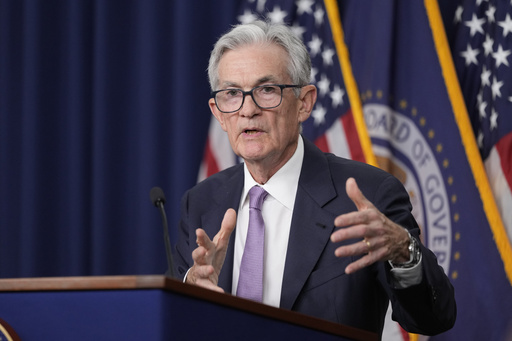
WASHIGNTON – The outcome of Tuesday’s presidential election remains uncertain, but the actions of the Federal Reserve two days later appear to be more predictable. With inflation rates continuing to decline, the Fed is anticipated to implement a second interest rate cut this year.
While the presidential election results may still be unknown when the Fed concludes its two-day meeting on Thursday afternoon, this uncertainty should not impact its decision to lower the benchmark rate. However, once a new president and Congress are sworn in come January, particularly if Donald Trump regains the presidency, the Fed’s future strategies may become more contentious.
Economists have raised concerns that Trump’s plans for imposing stringent tariffs on imports, mass deportations of undocumented immigrants, and potential interference in the Fed’s usual independent operations could trigger a surge in inflation. This uptick in inflation could force the Fed to hit pause on its rate reductions.
On Thursday, it is expected that the Fed, under the leadership of Chair Jerome Powell, will cut its benchmark rate by a quarter-point, lowering it to approximately 4.6%. This follows a previous half-point cut enacted in September. Analysts speculate that another quarter-point reduction could follow in December, with the possibility for further cuts in the upcoming year. Typically, rate cuts make borrowing cheaper for both consumers and businesses.
Interestingly, the Fed is decreasing rates for a different set of reasons than it usually would. Typically, rate cuts are utilized to stimulate a faltering economy or a weak job market by making borrowing and spending more appealing. However, the current economic situation shows robust growth, with the unemployment rate reported at a low 4.1%, even amidst setbacks caused by hurricanes and a strike at Boeing, which hindered net job growth last month.
Powell has characterized the interest rate reductions as part of a “recalibration” intended to transition to a lower-inflation landscape. In response to a significant inflation spike of 9.1% recorded in June 2022, the Fed raised rates 11 times, resulting in a peak rate of about 5.3%—the highest seen in four decades. However, as of September, inflation has eased to 2.4% year-over-year, almost aligning with the Fed’s target of 2% and matching levels from 2018. Fed officials suggest that high borrowing rates are no longer required since inflation has now subsided considerably.
Claudia Sahm, chief economist at New Century Advisors and a former Fed economist, noted, “The restriction was in place because inflation was elevated. Inflation is no longer elevated. The reason for the restriction is gone.” While Fed officials have indicated their rate cuts will occur gradually, most members support the idea of additional reductions.
Christopher Waller, a key member of the Fed’s Board of Directors, has previously stated that the critical question revolves around how quickly and how far to lower the target for the Fed’s key rate, which he perceives as currently being set restrictively. Jonathan Pingle, an economist at UBS, indicated that Waller’s comments reflect a strong belief that rates will decrease.
In the coming year, the Fed may need to confront the challenge of determining how low its benchmark rate should go. Eventually, there may be a desire to adjust it to a “neutral” position, a term used by the Fed to signify a rate that neither restricts nor stimulates economic activity. While Powell and other officials acknowledge uncertainty regarding the precise location of this neutral rate, estimates suggest it hovers around 2.9%, with most economists believing it is closer to 3% to 3.5%.
Powell stated that officials will gauge the neutral rate by observing the economy’s response to rate cuts. Currently, many officials seem confident that the existing rate of 4.9% is significantly above the neutral point. However, some economists contend that the economy’s healthy outlook, even amid high borrowing costs, suggests that credit easing may not be necessary. They argue that the interest rates might already be near a benchmark that neither constrains nor invigorates economic growth.
“If the unemployment rate remains in the low 4’s and the economy is expected to grow at 3%, does it really matter that the Fed’s rate is between 4.75% and 5%?” queried Joe LaVorgna, chief economist at SMBC Nikko Securities. “What’s the rationale for such cuts now?”
With the Fed meeting scheduled right after Election Day, Powell is likely to field inquiries during his Thursday news conference regarding the presidential race’s outcome and its implications for the economy and inflation. He is expected to affirm that the Fed’s decision-making is independent of political influences.
During Trump’s presidency, he imposed tariffs on various items, including washing machines, solar panels, and steel, which President Joe Biden continued. Studies indicate that while washing machine pricing increased as a result, overall inflation stayed relatively steady. Presently, Trump is advocating for broader tariffs—essentially import taxes—that would elevate prices across a vastly wider array of international goods.
Many mainstream economists have raised alarms over Trump’s latest tariff proposals, asserting that they could potentially rekindle inflation. A report from the Peterson Institute for International Economics concluded that these tariff measures could lead to an inflation increase of two percentage points next year. Some economists at Pantheon Macroeconomics suggest that the Fed may face more pressure to raise rates in response to Trump’s proposals this time around, given the scale of the tariffs he is threatening.
They noted that, “In light of these developments, we may adjust our reduction forecasts for the funds rate in 2025 should Trump win the election.”
